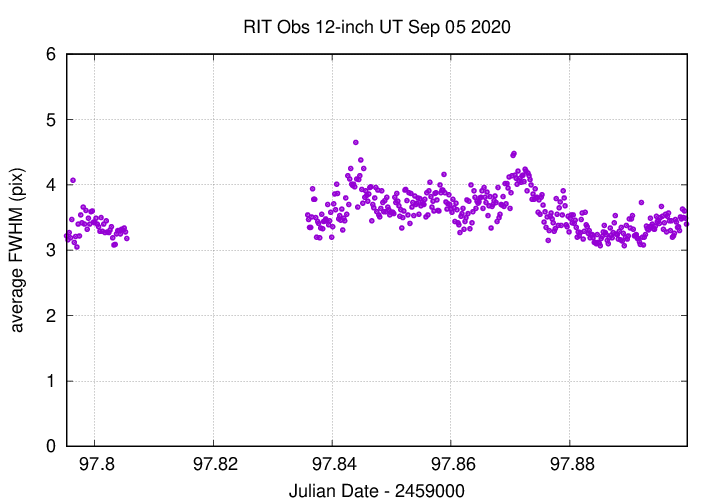
On the night of Sep 04/05, 2020, under good conditions, I acquired more test images of the eclipsing variable star RT And; one of my capstone students will be following it later this semester.
I also acquired images of Ross 248 and GX And for our continuing study of their parallax and proper motion.
You can find some basic information on this star at the SIMBAD's page for it.
The main setup was:
Notes from the night:
I used the guider when observing RT And. It worked fine for 50 minutes or so, but at 3:50 AM, I noticed that MaximDL had frozen. I had to force-close it, then restart MaximDL. The telescope was somehow affected, too -- it stopped tracking, and the handpaddle froze for about one minute. Fortunately, the handpaddle eventually responded. The guider dark had to be re-set, so I wonder if the guider was the source of the problems; it does communicate with the mount, after all. So, I stopped guiding. If this happens again, I may have to change the guider setup, or just quit guiding.
The object is at
RA = 23 11 17.9 Dec = +52 59 59.2 (J2000)
A chart of the field based on pictures tonight is shown below. The size of the chart is about 38 x 26 arcminutes.

The stars "A", "B", and "C" appear in the charts and tables for this field made by the AAVSO. see
I used the star labelled A = "102" to shift my R-band measurements to the "V" magnitude scale. Yes, that's right: shifting "R" to "V". It's wrong, but it will get us in the ballpark.
Here's a picture of the TV with the finder's field of view when pointing at RT And:

The dark current was normal this evening:

The sky value shows that the sky was mostly clear, but grew brighter towards dawn. I have seen these semi-periodic, small dips in the sky value on a number of nights recently. I don't understand what causes them ... must work on this mystery.

The number of objects detected.

I used an aperture of 5 arcsec for photometry.

Using aperture photometry with a radius of 5 pixels (binned 2x2, each pixel is 1.25 arcsec, so a radius of 6.25 arcsec), I measured the instrumental magnitudes of a number of reference stars and the target. Following the procedures outlined by Kent Honeycutt's article on inhomogeneous ensemble photometry, I used all stars available in each image to define a reference frame, and measured each star against this frame.
Sigma-vs-mag plots show that the floor was about 0.011 mag with 5-second exposures, and about 0.005 mag with 20-second exposures. However, RT And was nearly saturated in the 20-second exposures, so some short exposure time will probably be best.

A few jumps in the photometric solution may be due to wisps of cloud, or some problem with tracking.

Here are light curves of the variable and the field stars. Remember, the "magnitude" here is measured through an "R" filter, but shifted to match the "V" scale. Don't pay attention to the numbers.

This is one of the stars that a capstone student may study over the next year in a project involving parallax. Ross 248 is a relatively faint red star surrounded by many other stars of similar brightness, so it's a good candidate for high-precision parallax measurements.
These observations involved:
The object is (currently) near position
RA = 23:41:55.27 Dec = +44:10:06.38 (J2000)
A chart of the field is shown below. The size of the chart is about 41 x 27 arcminutes. The noisy area at right (West) is the shadow of the guider's pickoff mirror.

I've marked the location of several comparison stars.
star UCAC4 B V r ------------------------------------------------------------------------- A UCAC4 671-120730 12.617 10.689 B UCAC4 671-120688 C UCAC4 671-120749 10.987 10.663 P kappa And 4.06 4.14 --------------------------------------------------------------------------
I took a photo of the finder TV's screen when pointing to Ross 248; this could be a useful reference for the future:

The sky value shows no sign of clouds.

The number of objects detected.

I used an aperture with radius 5.0 pixels tonight.

Here are the positions I've measured so far. Note the clear motion to the south-east (lower-left).

Like Ross 248, GX And is a nearby (binary) star which will be the target of a parallax project in the coming year. One of the two components is bright -- about mag V = 8 -- so one must use short exposures to prevent it from saturating the detector. That may mean that this system isn't as easy to measure as Ross 248 or some others.
The object is currently close to this position:
RA = 00:18:28.4 Dec = +44:01:31 (J2000)
but it does have a very high proper motion.
A chart of the field is shown below. The size of the chart is about 41 x 27 arcminutes. The noisy area at right (West) is the shadow of the guider's pickoff mirror.

The two components of the GX And binary sit inside the box. I've marked the location of several comparison stars as well.
star UCAC4 B V r ----------------------------------------------------------- A 671-001473 9.939 9.790 B 670-001639 9.413 8.472 C 671-001509 12.712 11.421 11.001 -----------------------------------------------------------
I took a photo of the finder TV's screen when pointing to GX And; this could be a useful reference for the future:

I took a total of 112 exposures of the field in R-band, using exposure times of 5 seconds.
Using the same techniques as described for earlier nights, I matched detected stellar positions to the Gaia DR2 catalog.
The target is clearly moving in the positive RA and Dec directions, as we would expect from its known (large) proper motion.

Last modified 9/6/2020 by MWR.